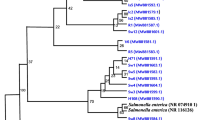Abstract
Objective
To determine nasopharyngeal carriage rate and prevalent serogroups/ types (SGT) of S. pneumoniae in healthy children, assess their antimicrobial susceptibility and its implications over the heptavalent pneumococcal conjugate vaccine.
Methods
200 healthy children aged between 3 months and 3 years attending Pediatric OPD at Sir Ganga Ram Hospital, New Delhi were studied. A nasopharyngeal swab was collected from each child which was processed to isolate Streptococcus pneumoniae. Serotyping was performed by the Quellung reaction. Antimicrobial susceptibility patterns were determined by disk diffusion and E test methods.
Results
S. pneumoniae carriage rate was 6.5%. Isolates belonged to serotypes 1, 6, 14 and 19, of which serotype 19 was the most common. None of the strains were totally resistant to penicillin though 2 (15.4%) were intermediately resistant. Overall, 84.6% of the isolates belonged to the strains covered by the heptavalent pneumococcal vaccine.
Conclusion
The heptavalent conjugate vaccine covers most isolated strains, but since the number of strains is very small, it is suggested that there is need for further studies in different regions to assess the usefulness of this vaccine.
Similar content being viewed by others
References
Narain JP, Sehgal PN. Acute respiratory infection. A priority heath problem in India. J Com Dis 1987; 19: 381–386.
Klugman KP. Pneumococcal resistance to antibiotics. Clin Microbiol Rev 1990; 3: 171–196.
National committee for Clinical Laboratory Standards. Performance Standards for Antimicrobial Disk Susceptibility Testing: twelfth informational supplement. NCCLS document M100-S13. USA; Pennsylvania, National committee for Clinical Laboratory Standards, 2004.
Invasive Bacterial Infection Surveillance (IBIS) Group, International Clinical Epidemiology Network (INCLEN). Prospective Multicentre hospital Surveillance of Streptococcus pneumoniae diseases in India. Lancet 1999; 353: 1216–1221.
Eskola J, Kilpi T, Palmu A et al. Efficacy of a pneumococcal conjugate vaccine against otitis media. N Eng J Med 2001; 344: 403–409.
Sleeman K, Knox K, George R et al. Invasive pneumoccal disease in England and Wales: vaccination impications. J Infect Dis 2001; 183: 239–246.
Hausdorff WP, Bryant J, Paradiso PR, Siber GR. Which pneumoccal serogroups cause the most invasive disease: implications for conjugate vaccine formulation and use., part I. Clin Infect Dis 2000; 30: 100–121.
Kar UK, Satpathy S, Nayak N, Das BK, Panda SK. Serotype distribution of Streptococcus pneumoniae isolates from ophthalmic and systemic infections and of commensal origin. Ind J Med Res 2006; 124: 99–104.
Jain A, Kumar P, Awasthi S. High nasopharyngeal carriage of drug resistant Streptococcus pneumoniae and Haemophilus influenzae in North Indian schoolchildren. Trop Med Int Heath 2005; 10: 234–239.
Author information
Authors and Affiliations
Corresponding author
Rights and permissions
About this article
Cite this article
Wattal, C., Oberoi, J.K., Pruthi, P.K. et al. Nasopharyngeal carriage of Streptococcus pneumoniae . Indian J Pediatr 74, 905–907 (2007). https://doi.org/10.1007/s12098-007-0166-z
Received:
Accepted:
Published:
Issue Date:
DOI: https://doi.org/10.1007/s12098-007-0166-z




